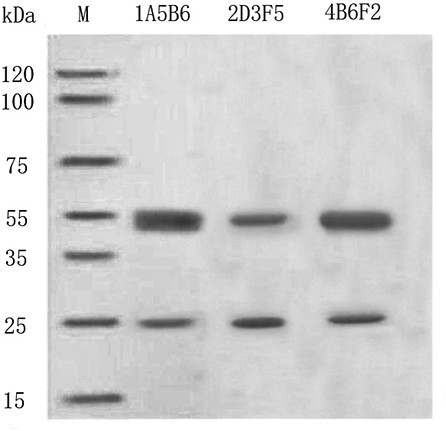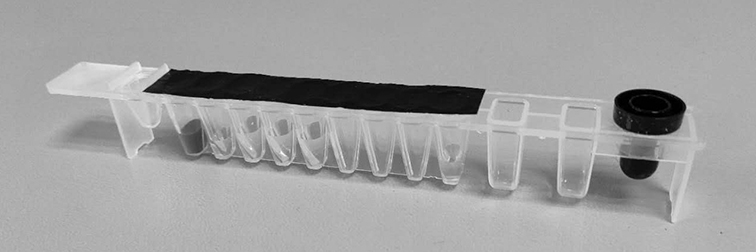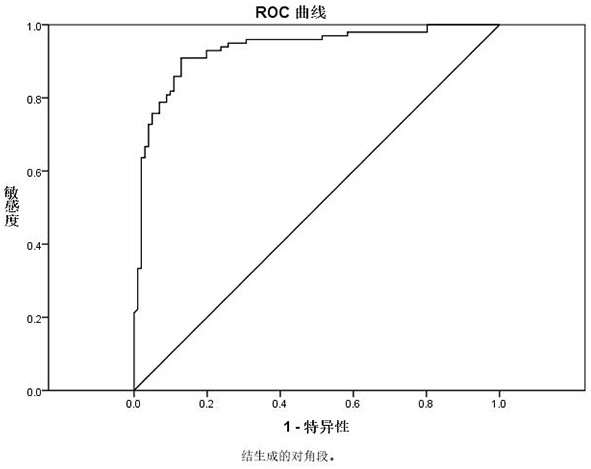Hybridoma cell strain capable of secreting anti-Spondin1 monoclonal antibody as well as monoclonal antibody and application of monoclonal antibody
A technology of hybridoma cell line and monoclonal antibody, which is applied in the direction of anti-receptor/cell surface antigen/cell surface determinant immunoglobulin, analytical materials, anti-animal/human immunoglobulin, etc., which can solve the problem of poor specificity of antibodies , Sensitivity effects, inability to distinguish Spondin1 highly homologous family proteins, etc., to achieve strong specificity and high sensitivity
- Summary
- Abstract
- Description
- Claims
- Application Information
AI Technical Summary
Problems solved by technology
Method used
Image
Examples
Embodiment 1
[0022] Embodiment 1, recombinant protein expression and purification of Spondin1
[0023] After extracting RNA from ovarian cancer tissue, the cDNA obtained by RT-PCR with random primers was used as a template, and primers were designed to clone the Spondin1 gene. The specific primers were: Spondin1-F: 5'-TGTTCATCCTTGTTA-3' (SEQ ID NO.1); Spondin1-R: 5'-CGGGGACAGCCTCAT-3' (SEQ ID NO. 2). The amplified Spondin1 gene was inserted into the pcDNA3.1 vector containing 6×His tag to obtain Spondin1-pcDNA3.1. Then Spondin1-pcDNA3.1 was transformed into DH5α, positive clones were picked and cultured in large quantities, and the recombinant plasmid Spondin1-pcDNA3.1 was extracted with a high-purity plasmid extraction kit. The recombinant plasmid was transferred into 293T cells, and the pcDNA3.1 empty vector was transfected at the same time as a negative control. 2 Cultivate for 72 hours under the condition, collect the supernatant, and filter the supernatant with a 0.22 μm filter memb...
Embodiment 2
[0025] Embodiment 2, the preparation of Spondin1 monoclonal antibody hybridoma cell line
[0026] Mouse immunization: 3 batches of BALB / c mice were immunized with Spondin1 protein, 3 mice each time. Each mouse was immunized with 50 μg antigen each time. For the first immunization, Spondin1 antigen was mixed with Freund's complete adjuvant 1:1, and then Spondin1 was mixed with Freund's incomplete adjuvant 1:1, immunized once every two weeks, a total of 3 immunizations, and the tail was docked ten days after the third immunization Blood collection, detection of serum titer.
[0027] Hybridoma cell fusion: After detecting that the titer of mouse serum reaches 1:100000, use Spondin1 antigen (without adjuvant) to boost intraperitoneal immunization (30 μg), and aseptically collect spleen cells and SP2 / 0 mouse bone marrow from immunized mice 3 days later Tumor cells were mixed in a 50mL centrifuge tube at a ratio of 4:1, washed twice with medium, discarded the supernatant, and then...
Embodiment 3
[0029] Example 3, Spondin1 monoclonal antibody preparation, purification, titer detection and specificity analysis
[0030]Monoclonal antibody ascites preparation: Culture the 3 screened hybridoma cell lines in culture medium to 90% density, collect the cells, and dilute the cells to 3×10 6 individual / mL. After 10-12 weeks of adaptive feeding of BALB / c mice for one week, intraperitoneal injection of immunosuppressant liquid paraffin, 0.5mL / mouse, 7 days later, the abdomen was inoculated with hybridoma cells that stably secreted antibodies and were in good condition, about (1-2) ×10 6 One per mouse, after 7-10 days, the abdomen of the mice was inflated, the ascites was extracted, and the supernatant of the ascites was collected.
[0031] Antibody purification: Collect mouse ascites, filter the solution with a 0.45 μm filter, add solid ammonium sulfate with a final concentration of 50%, stir evenly at 4°C, let stand for 1 hour, collect the precipitate at 12000 rpm, and redisso...
PUM
| Property | Measurement | Unit |
|---|---|---|
| Purity | aaaaa | aaaaa |
Abstract
Description
Claims
Application Information
 Login to View More
Login to View More - R&D
- Intellectual Property
- Life Sciences
- Materials
- Tech Scout
- Unparalleled Data Quality
- Higher Quality Content
- 60% Fewer Hallucinations
Browse by: Latest US Patents, China's latest patents, Technical Efficacy Thesaurus, Application Domain, Technology Topic, Popular Technical Reports.
© 2025 PatSnap. All rights reserved.Legal|Privacy policy|Modern Slavery Act Transparency Statement|Sitemap|About US| Contact US: help@patsnap.com



